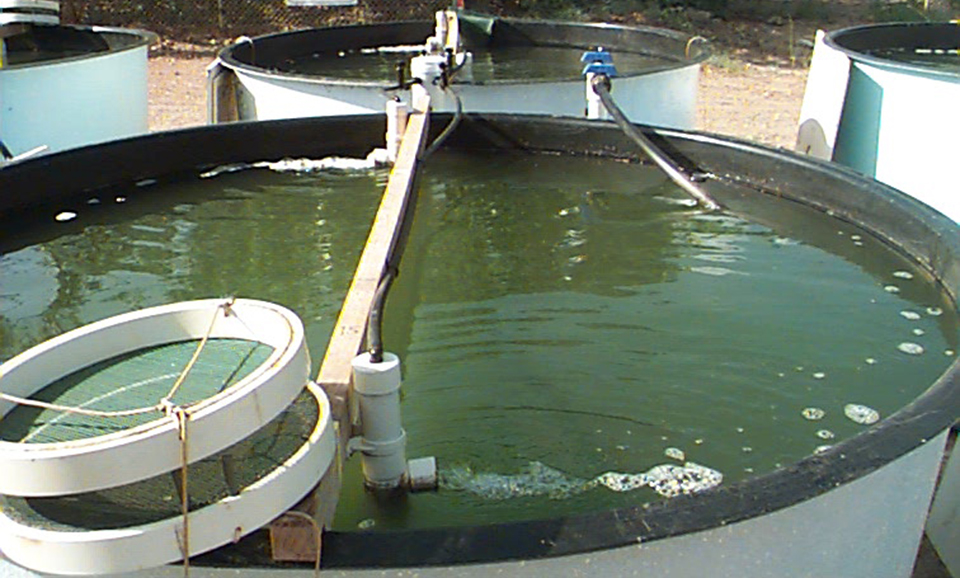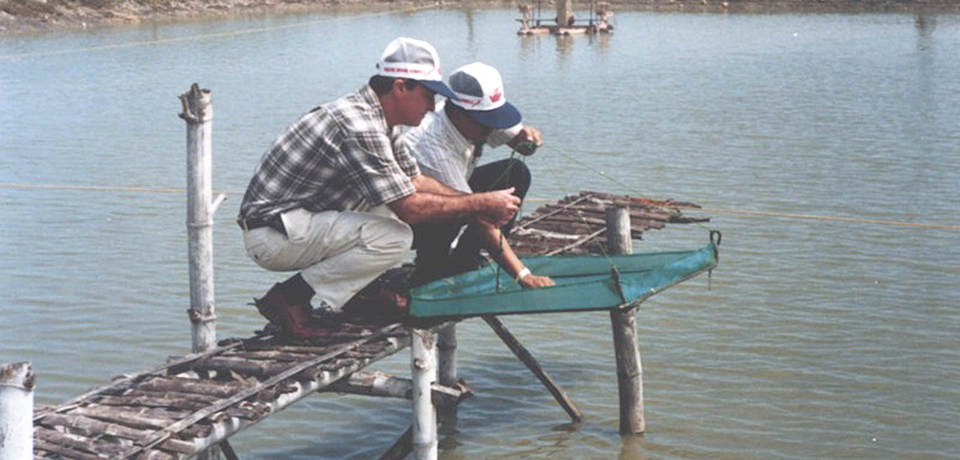No need to feed more than three times per day with adequate feeds and water stability

Feeding frequency is an integral part of feed management. It is generally believed that distributing a daily ration as multiple feedings improves shrimp growth and reduces water quality deterioration. However, few experiments have been conducted to confirm the benefit of this feed management strategy for shrimp culture.
Feeding practices in Latin America
Shrimp reared under semi-intensive conditions on farms in Latin American are most commonly fed once or twice daily, usually in the morning and afternoon. Although nocturnal feeding habits have been reported for most penaeid shrimp, on-farm studies with (Litopenaeus vannamei) suggested day feeding is as productive as night feeding.
In response to the presence of White Spot Syndrome Virus (WSSV), some farmers now conduct the grow-out cycle in two phases. In the first, or nursery, phase, shrimp are held in raceways or small ponds and fed 6 to 8 times per day. For the second phase, shrimp are transferred to larger ponds and feed is offered 1 to 2 times per day.
When there are indications of a disease outbreak, particularly WSSV, farmers increase ration size and frequency of feeding for a few days in an attempt to increase nutrient intake during this critical period. However, with this feeding strategy, production results have been quite variable, even with commercial feeds.
Feeding practices in southeast Asia
In Southeast Asia, where most of the world’s production of Penaeus monodon occurs, postlarvae are stocked directly into ponds or held in nursery enclosures before being released to the grow-out ponds. Recommended feeding practices for postlarvae during the first 30 days are quite variable: 2 to 6 feedings per day. However, during grow-out, the recommended feeding frequencies are 4 times per day for shrimp of 3 to 14 grams and 5 times per day for shrimp above 14 grams.

Experiments with L. vannamei
To determine the effects of feeding frequency and daily ration allocation on shrimp growth and the accumulation of inorganic nitrogen and phosphorus in culture water, two static-water experiments were conducted. Culture seawater salinity was 22 to 27 0/00, while temperatures were 29 to 31 degrees-C. Aeration was supplied via a single airstone, and dissolved oxygen concentration was maintained above 4.0 ppm in each tank.
Experiment 1
The first experiment tested five feeding frequencies (3, 5, 8, 11, and 15 feedings per day) evenly spaced in time throughout each day for three weeks with shrimp of about 0.2 g initial weight. Daily ration, slightly in excess of expected satiety, was divided into similar amounts for each feeding.
Mean shrimp survival for all treatments was 98.6 percent. With pH of 7.8 to 8.0, the average concentrations of total ammonia-nitrogen and nitrite-nitrogen ranged 0.03 to 0.16 and 0.008 to 0.01 milligrams per liter, respectively. No significant differences were found for shrimp growth (9.4 grams mean), accumulation of total inorganic nitrogen (TIN), or total reactive phosphorus (TRP), regardless of feeding frequency.
Experiment 2
Because continuous feeding of shrimp is seldom performed in other than intensive culture systems, a second experiment was conducted with 0.5 to 0.6-gram shrimp in which the following feeding strategies were compared: 1 (100 percent of daily feed given at 8:00 a.m.); 2 (50 percent each at 8:00 a.m. and 8:00 p.m.); 3 (33 percent each at 8:00 a.m., 2:00 p.m., and 8:00 p.m.); 4 (45, 20, and 35 percent at 8:00 a.m., 2:00 p.m., and 8:00 p.m., respectively); 5 (25 percent each at 8:00 a.m., noon, 4:00 p.m., and 8:00 p.m.), 6 (40, 15, 15, and 30 percent at 8:00 a.m., noon, 4:00 p.m., and 8:00 p.m., respectively), 7 (16.6 percent each at 8:00 and 10:30 a.m., and 1:00, 4:00, 6:00, and 8:00 p.m.); and 8 (15 times per day, every 96 minutes) for four weeks.
Shrimp survival was 100 percent for all treatments (Table 1). Although mean shrimp growth was highest at two feedings per day, no significant differences were found among the feeding treatments. Average concentrations of total ammonia-nitrogen ranged 0.17 to 0.50 (pH = 7.9 to 8.2) and nitrite-nitrogen ranged 0.10 to 0.30 milligrams per liter. Accumulation of TIN in the culture water was significantly lower for the tanks that received two feedings per day as compared to those with 1 and 3 feedings per day. Levels of TIN were not significantly different among the other feeding treatments. Accumulation of TRP was not significantly different among the treatments.
Velasco, Performance of L. vannamei, accumulation of nitrogen and phosphorus in culture water, Table 1
| Treatment No.: | 1 | 2 | 3 | 4 | 5 | 6 | 7 | 7 |
|---|---|---|---|---|---|---|---|---|
| Feeding frequency (feedings/day) | 1 | 2 | 3 | 3+ | 4 | 4+ | 5 | 15 |
| Survival (%) | 100 | 100 | 100 | 100 | 100 | 100 | 100 | 100 |
| Biomass gain (g) | 2.1 | 2.6 | 2.2 | 2.2 | 2.3 | 2.3 | 2.4 | 2.3 |
| Feed-conversion ratio | 2.1 | 1.6 | 1.9 | 1.9 | 1.8 | 1.8 | 1.7 | 1.8 |
| Total inorganic nitrogen (mg/l) | 2.47a | 0.54a | 2.58ab | 1.93ab | 1.42ab | 1.56ab | 1.92ab | 1.37ab |
| Total reactive phosphorus (mg/l) | 1.51 | 1.41 | 1.42 | 1.42 | 1.44 | 1.44 | 1.43 | 1.51 |
This data indicated that under these culture conditions, increasing feeding frequency or manipulating ration quantity did not significantly improve shrimp survival or growth. The lower TIN levels in the water concomitant with the higher growth of shrimp receiving two feedings per day may possibly reflect better synchronization between shrimp activity level, food intake, and circadian endogenous digestive enzymes variations. Consequently, more nitrogen was retained in shrimp tissue and less was detected in the water.
CENAIM study
Between 2000 and 2003, the Ecuadorian National Center for Aquaculture and Marine Research reported results that related feeding with molt and circadian cycles. Under laboratory conditions, higher protease, amylase and lipase enzymatic activities were reported when shrimp were fed twice daily at noon and 8:00 p.m. Moreover, under field conditions, enzymatic activity appeared to relate to time of feeding, with higher activity when feeding twice at 8:00 a.m. and 8:00 p.m. This feeding regimen also yielded higher shrimp production.
Experiments with P. monodon
The effects of four feeding strategies (3, 4, 5 and 6 feedings per day) on the growth and survival of black tiger shrimp, P. monodon, and water quality were studied in an eight-week growth trial. The shrimp were held in 2,500-liter outdoor tanks containing water and sediment from a shrimp pond, with five replicate tanks randomly assigned for each treatment.
Shrimp with initial weights of 5.6 ± 0.10 grams were stocked at a density of 25 animals per square meter and fed a widely used, commercial pelleted feed from feeding trays. The uneaten feed on trays was removed at specific time intervals so that in all treatments, the shrimp had access to feed for a total of 12 hours per day.
The water management and aeration strategies were designed to simulate a shrimp pond system, with water exchanges carried out to maintain a stable algal bloom. Mean water temperatures varied between about 25 degrees-C at 5:00 a.m. and a maximum of about 28 degrees-C at 2:00 p.m. In the early stages of the experiment, 10-20 percent of the water in every tank was removed and replaced with clean oceanic water once each week. During the later stages of the experiment, this replacement was increased to a 10 percent exchange every two or three days.
Feeding frequency did not change the growth rate or survival of the shrimp. All shrimp grew at similar rates (about 1.4 ± 0.10 grams per week) and reached similar final weights. Survival rates (84 ± 7.6 percent) were also not significantly different among treatments. In addition, feed intake and feed-conversion ratios (2.0 ± 0.27) did not change significantly with feeding frequency.
Water quality remained similar despite the different feeding frequencies. There were no significant differences among treatments for water quality measurements of total nitrogen, ammonium, nitrate/nitrite, DON, total phosphorus, phosphate, chlorophyll a, oxygen, pH, temperature, salinity, and turbidity.
Conclusion
The results of the two studies reported here indicated that both L. vannamei and P. monodon did not need to be fed more than three times per day when provided nutritionally adequate feeds with high water stability. In addition, less-frequent feeding is not likely to adversely affect water quality, and so will not increase the nutrient loads in pond discharge water.
It may therefore be possible to reduce feeding frequency in commercial shrimp ponds during the grow-out phase without adversely affecting growth rate and survival, thereby improving profitability. However, since it is difficult to accurately assess the true effects of feeding frequency, it is important that these findings be confirmed under commercial conditions, possibly in well-designed, replicated studies using cages placed in ponds.
(Editor’s Note: This article was originally published in the December 2003 print edition of the Global Aquaculture Advocate.)
Now that you've finished reading the article ...
… we hope you’ll consider supporting our mission to document the evolution of the global aquaculture industry and share our vast network of contributors’ expansive knowledge every week.
By becoming a Global Seafood Alliance member, you’re ensuring that all of the pre-competitive work we do through member benefits, resources and events can continue. Individual membership costs just $50 a year. GSA individual and corporate members receive complimentary access to a series of GOAL virtual events beginning in April. Join now.
Not a GSA member? Join us.
Authors
-
Mario Velasco, Ph.D.
Empacadora Nacional C.A.
P.O. Box 09-01-4344
Guayaquil, Ecuador[100,110,97,99,101,46,116,101,110,46,97,117,99,101,64,111,99,115,97,108,101,118,109]
-
David Smith, Ph.D.
CSIRO Marine Research
Cleveland, Queensland, Australia
Tagged With
Related Posts

Health & Welfare
CENIACUA develops WSSV-resistant shrimp in Colombia
To combat white spot syndrome virus (WSSV) in white shrimp, Corporación Centro de Investigación de la Acuacultura de Colombia (CENIACUA) initiated a selective-breeding program to develop resistance in shrimp.

Health & Welfare
Children’s hospital Boston makes zebrafish feeding regime breakthrough
Zebrafish offer a living model system for research in a wide variety of scientific disciplines. The Aquatic Resources Program at Children’s Hospital Boston recently identified an alternative feeding method that requires less labor.

Aquafeeds
Mycotoxin prevention in aquaculture feeds
Mycotoxins are naturally occurring, toxic chemical compounds produced by molds. When they infect aquaculture feeds and feed ingredients, mycotoxins can affect growth, reproduction and immunity in fish.

Health & Welfare
Trials advance low-salinity culture of cobia, pompano, other species
Collaborative research in Florida is developing technologies for rearing marine fish in low-cost, low-salinity recirculating systems. Spawning and larval production studies have led to the mass production of juveniles.


